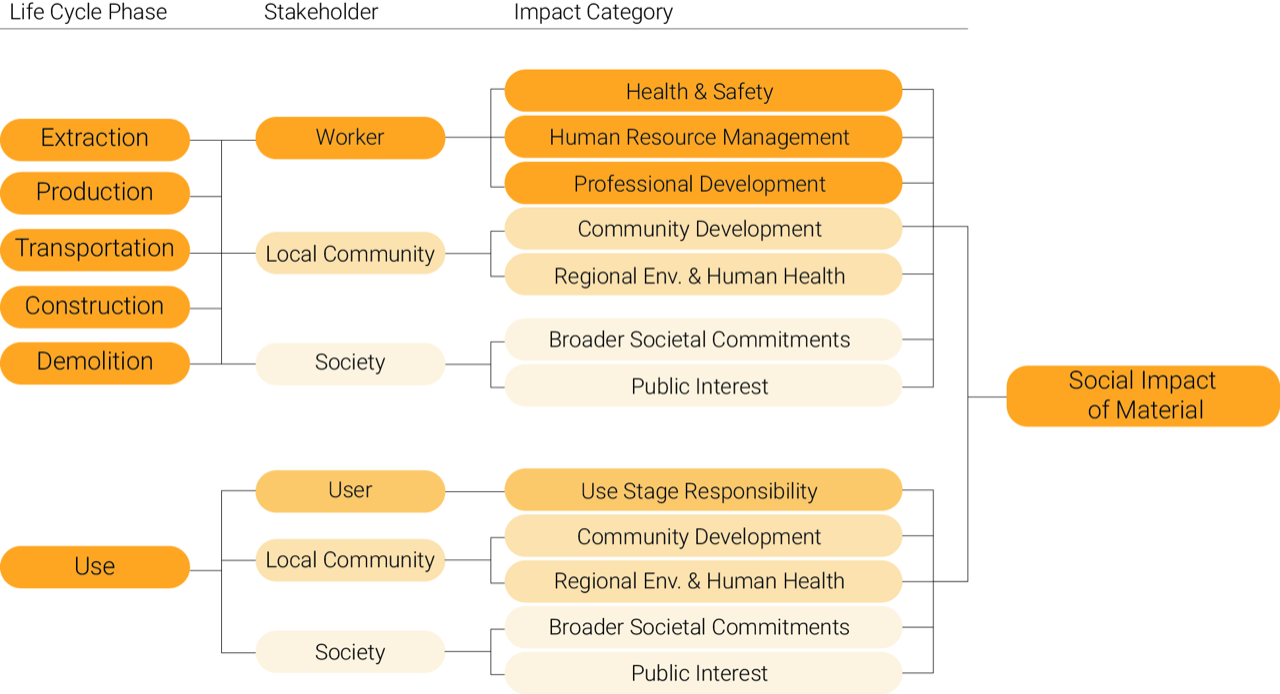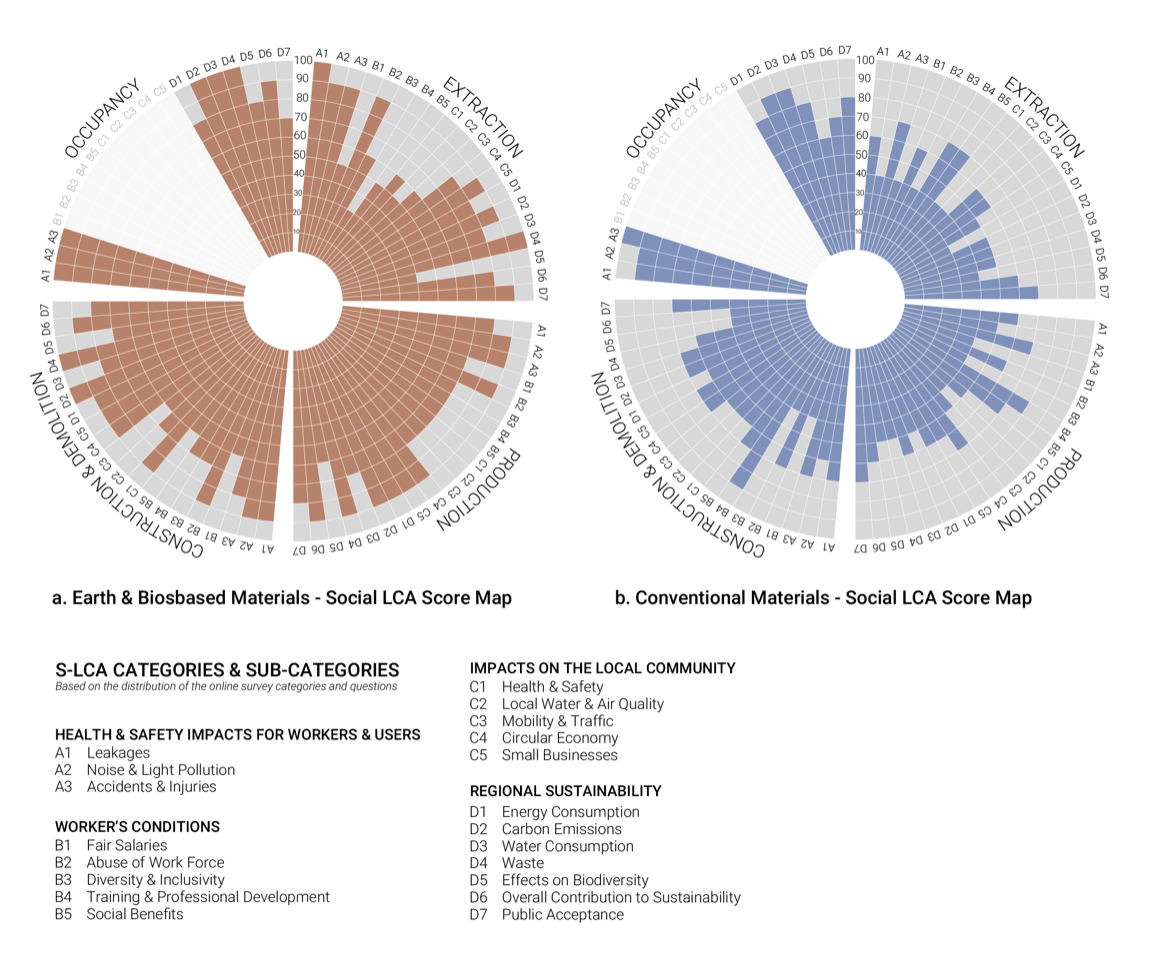LIFE CYCLES: ENVIRONMENTAL AND SOCIAL
This line of research introduces critically needed life cycle inventory and impact assessments, including cradle-to-grave environmental and social life cycle assessments and biogenic carbon storage enumeration.
There is a widespread consensus on the environmental and social benefits of earth- and bio-based materials; however, a systematic analysis that quantifies these benefits is criticlaly needed advance policy for radically low-carbon built environment. This line of work develops environmental and social life cycle assessments (ELCA and SLCA), using ISO-compliant robust methodologies, to contribute to a full triple bottom line life cycle assessment of earth- and bio-based materials.
This research enumerates impact results related to energy, carbon, and other emissions, as well as health, wellnbeing, working conditions, and circular economy, using a range of tool: environmental and energy simulations, and online surveys of stakeholders such as manufacturers, designers, researchers, and homeowners.
There is a widespread consensus on the environmental and social benefits of earth- and bio-based materials; however, a systematic analysis that quantifies these benefits is criticlaly needed advance policy for radically low-carbon built environment. This line of work develops environmental and social life cycle assessments (ELCA and SLCA), using ISO-compliant robust methodologies, to contribute to a full triple bottom line life cycle assessment of earth- and bio-based materials.
This research enumerates impact results related to energy, carbon, and other emissions, as well as health, wellnbeing, working conditions, and circular economy, using a range of tool: environmental and energy simulations, and online surveys of stakeholders such as manufacturers, designers, researchers, and homeowners.

The results, published in a series of manuscripts, and provided in terms of health and safety, worker conditions, and regional impacts, showing that earth- and bio-based materials outperform conventional materials in almost all aspects of the SLCA framework, with the exception of the provision of social benefits and professional development opportunities for workers in the extraction, production, and construction phases.



For the environmental life cycle assessment (LCA) of natural earthen and bio-based materials compared to conventional building materials, we used 6 climates: hot desert, desert, semi-arid, Mediterranean, temperate, and continental. Results show that, when coupling the embodied and operational environmental impacts, the natural assemblies are shown to reduce energy demand 32-59% for the hot desert climates, 29-55% in semi-arid climates, 46-73% in Mediterranean climates, 34-57% in temperate climates and 27-50% in continental climates as compared to conventional assemblies. The operational impacts are shown to be highly dependent on the thermal properties and climate zone, but in all cases natural assemblies outperform conventional assemblies. In particular, light straw clay and insulated rammed earth are the top performers for all 6 climates. The work presented in this paper contributes critically needed environmental quantifications to catalyze the advancement of healthier and more environmentally sound commitments to ecological construction worldwide.


date:
2020 - ongoing
collaborators:
Vivian Loftness, Erica Cochran Hameen, Kent Harries, Gwen DiPietro
research students:
Zina Berrada
publications:
Ben-Alon, L., Loftness, V., Harries, K. A., & Hameen, E. C. (2021). Life cycle assessment (LCA) of natural vs conventional building assemblies. Renewable and Sustainable Energy Reviews, 144, 110951. Link︎︎︎
Ben-Alon, L., Loftness, V., Harries, K. A., DiPietro, G., & Hameen, E. C. (2019). Cradle to site Life Cycle Assessment (LCA) of natural vs conventional building materials: A case study on cob earthen material. Building and Environment, 160, 106150. Link︎︎︎
Ben-Alon, L., Loftness, V., Harries, K. A., & Hameen, E. C. (2019, August). Integrating earthen building materials and methods into mainstream construction using environmental performance assessment and building policy. In IOP conference series: earth and environmental science (Vol. 323, No. 1, p. 012139). IOP Publishing. Link︎︎︎
Ben-Alon, L., Loftness, V., Harries, K. A., DiPietro, G., & Hameen, E. C. (2019). Cradle to site Life Cycle Assessment (LCA) of natural vs conventional building materials: A case study on cob earthen material. Building and Environment, 160, 106150. Link︎︎︎
Ben-Alon, L., Loftness, V., Harries, K. A., & Hameen, E. C. (2019, August). Integrating earthen building materials and methods into mainstream construction using environmental performance assessment and building policy. In IOP conference series: earth and environmental science (Vol. 323, No. 1, p. 012139). IOP Publishing. Link︎︎︎
